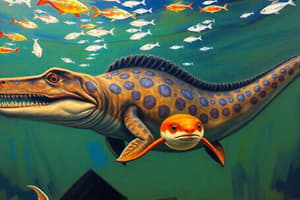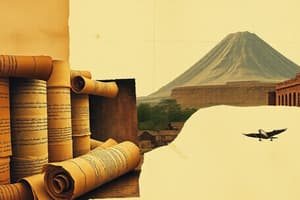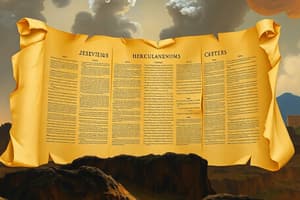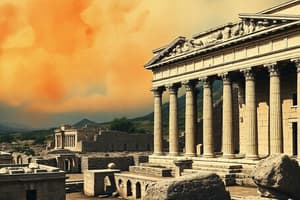Podcast
Questions and Answers
What was the total prize amount that Farritor and Nader received for the 'First Letters Prize'?
What was the total prize amount that Farritor and Nader received for the 'First Letters Prize'?
- $50,000 (correct)
- $60,000
- $30,000
- $40,000
How much of the scroll did the team successfully decode?
How much of the scroll did the team successfully decode?
- 3.5
- 5 (correct)
- 2.5
- 5.3
Who is the philosopher attributed to the decoded passages?
Who is the philosopher attributed to the decoded passages?
- Epicurus
- Aristotle
- Philodemus (correct)
- Plato
What is the cash prize offered for decoding at least 90 percent of the scrolls?
What is the cash prize offered for decoding at least 90 percent of the scrolls?
Which themes did Philodemus explore in the decoded texts?
Which themes did Philodemus explore in the decoded texts?
What significant event in 79 AD led to the preservation of the scrolls found in Herculaneum?
What significant event in 79 AD led to the preservation of the scrolls found in Herculaneum?
Which of the following statements best describes the initial condition of the Herculaneum scrolls when found?
Which of the following statements best describes the initial condition of the Herculaneum scrolls when found?
What technology did Brent Seales develop to analyze the scrolls without unrolling them?
What technology did Brent Seales develop to analyze the scrolls without unrolling them?
What was the primary goal of the Vesuvius Challenge initiated by Seales and his team?
What was the primary goal of the Vesuvius Challenge initiated by Seales and his team?
What is the significance of the first word identified from the Herculaneum scrolls?
What is the significance of the first word identified from the Herculaneum scrolls?
Which challenge did researchers face when mechanically unrolling the scrolls?
Which challenge did researchers face when mechanically unrolling the scrolls?
Which of the following best explains why deciphering the contents of the scrolls is complex?
Which of the following best explains why deciphering the contents of the scrolls is complex?
What outcome did Seales anticipate from involving students in the Vesuvius Challenge?
What outcome did Seales anticipate from involving students in the Vesuvius Challenge?
Flashcards
Herculaneum Library
Herculaneum Library
A library discovered in the ancient Roman city of Herculaneum, buried by Mount Vesuvius' eruption in 79 AD. It contains over 1,800 rolled papyrus scrolls.
Vesuvius Scrolls
Vesuvius Scrolls
The papyrus scrolls discovered in the Herculaneum library, preserved due to the lack of oxygen during Vesuvius' eruption, providing insights into ancient life.
Virtual Unwrapping
Virtual Unwrapping
A non-invasive technique using X-ray technology to digitally analyze the contents of rolled-up scrolls without physically opening them.
Vesuvius Challenge
Vesuvius Challenge
Signup and view all the flashcards
AI Ink Detection
AI Ink Detection
Signup and view all the flashcards
First Word Deciphered
First Word Deciphered
Signup and view all the flashcards
What is 'Porphyras'?
What is 'Porphyras'?
Signup and view all the flashcards
Why are the Vesuvius Scrolls important?
Why are the Vesuvius Scrolls important?
Signup and view all the flashcards
Philodemus
Philodemus
Signup and view all the flashcards
Deciphered Scroll Content
Deciphered Scroll Content
Signup and view all the flashcards
Scroll's Importance
Scroll's Importance
Signup and view all the flashcards
Vesuvius Challenge Goal
Vesuvius Challenge Goal
Signup and view all the flashcards
Incentive for Decoding
Incentive for Decoding
Signup and view all the flashcards
Study Notes
The Vesuvius Challenge: Deciphering Ancient Scrolls
- Mount Vesuvius' eruption in 79 AD buried Pompeii and Herculaneum, preserving ancient scrolls.
- In 1752, researchers unearthed over 1,800 papyrus scrolls in a Herculaneum mansion.
- The scrolls' interiors remained largely intact due to the lack of oxygen during the eruption.
Challenges in Unrolling and Deciphering
- Early attempts at mechanically unrolling scrolls damaged them, leading to dust.
- X-ray technology allowed non-invasive imaging of the scrolls, revealing letters and words, but ink was embedded.
- AI was developed to identify letters and symbols, but initial efforts needed assistance.
The Vesuvius Challenge Initiated
- Professor Brent Seales, using computer science, created an AI program and X-ray image database.
- The "Vesuvius Challenge" aimed to engage students in decoding the scrolls.
- Thousands of 3D X-ray images of scrolled papyri and fragments were released.
- Prizes were offered for significant contributions to deciphering.
Initial Success: Deciphering the First Word
- Luke Farritor (22), identified the Greek word for purple, "porphyras."
- Youssef Nader also found the same word, sharing the "First Letters Prize" ($50,000).
- Farritor received $40,000 and Nader received $10,000.
Further Progress and Team Collaboration
- Farritor, Nader, and Julian Schillinger decoded 85 percent of characters in four passages, each containing 140 characters.
- The trio read an additional 15 partial columns.
- About 5 percent of the scroll was decoded.
- The passages were of philosophical writings by Philodemus, discussing the relationship between abundance of goods and joy.
Future Goals and Larger Prize
- Seales aims to decode a complete scroll by year-end 2024.
- A $100,000 prize is offered to the first team deciphering 90% of all four scrolls.
Studying That Suits You
Use AI to generate personalized quizzes and flashcards to suit your learning preferences.





